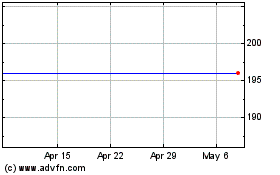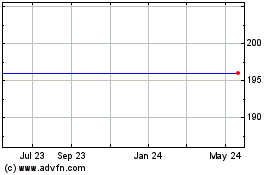By Jay Greene
Microsoft Corp. agreed to buy LinkedIn Corp. for $26.2 billion,
in a bet the professional social network will give a jolt to the
software giant's widely used Office portfolio of productivity
applications.
The deal -- the largest in Microsoft's history -- is CEO Satya
Nadella's latest move to revitalize a company that was viewed not
long ago as left behind by shifts in technology. Mr. Nadella is
betting the deal will open new horizons for Microsoft's Office
suite as well as LinkedIn, both of which have saturated their
markets, and generally bolster Microsoft's revenue and competitive
position.
Mr. Nadella said in an interview on Monday that "work today is
split" between tools workers use to get their jobs done, such as
Microsoft's Office programs, and professional networks that connect
workers. The deal, he said, aims to weave those two pieces
together.
"It's really the coming together of the professional cloud and
the professional network," Mr. Nadella said.
For instance, connecting Office directly to LinkedIn could help
attendees of meetings learn more about one another directly from
invitations in their calendars. Sales representatives could pick up
useful tidbits of background on potential customers from LinkedIn
data.
Microsoft also sees opportunities in Lynda.com, a channel for
training videos that LinkedIn bought for $1.5 billion last year.
Microsoft will be able to offer Lynda's videos inside its own
software, such as Excel spreadsheets.
Mr. Nadella also talked about adding data from LinkedIn to its
Cortana digital assistant.
Microsoft will pay $196 per LinkedIn share, a 50% premium to the
social network's closing price on Friday. Both boards approved the
deal, and Reid Hoffman, LinkedIn's chairman and controlling
shareholder, supports the transaction. The companies expect the
deal to close by the end of the year.
The tie-up will also test Microsoft's ability to meld a large
acquisition with its own operations. Redmond has struggled to
integrate previous purchases including Nokia Corp.'s handset
business and aQuantive Inc., costing shareholders billions of
dollars in the process.
As for LinkedIn, it lends hope to renew stalled growth as well
as an exit for shareholders after the stock tumbled from a peak of
$269 in February 2015 to as low as $101.11 last February.
LinkedIn's growth has stalled as advertising has struggled.
Customers who have purchased the company's recruiting products have
been leaving as well. The tie-up represents an opportunity to
jump-start growth by tapping into the vast reach of Office, used by
more than 1.2 billion customers.
LinkedIn Chief Executive Jeff Weiner, who will remain with the
company in the same job, said the deal provides "a meaningful
acceleration of the scale at which we operate."
Perhaps the biggest challenge for Microsoft will be digesting
LinkedIn. The deal dwarfs every other acquisition the company has
made. Microsoft's next largest deal, buying the Nokia handset
business, has been disastrous, with the company largely unwinding
the last pieces of that division, taking charges that slightly
exceed the $9.4 billion Microsoft ultimately spent to buy the
business. That deal was orchestrated in 2014 by Microsoft's
previous chief executive, Steve Ballmer.
"Sadly, history has shown [synergies] are very difficult to
realize when two big companies combine, especially to the extent
LinkedIn is remaining an independent fiefdom within the Microsoft
empire," said Mitch Kapor, founder of Lotus Development Corp. and
partner of venture firm Kapor Capital.
The deal highlights Mr. Nadella's bid to reshape Microsoft, a
little more than two years after taking the helm. Mr. Nadella, who
rose through Microsoft's ranks in its business applications and
server groups, has focused much of the company's efforts on
products and services for corporate customers.
As CEO, he extended Microsoft's software to platforms that it
doesn't control, including Android mobile phones and the Linux
desktop operating system. And he has pushed to connect Microsoft's
products to data sources that can provide customers with timely,
useful information, and to develop services that rely on emerging
technologies such as machine learning that attempts to anticipate
information users want and actions they'll take.
Microsoft's efforts at weaving social networking into its
workplace products haven't caught fire. In 2012, Microsoft bought
workplace chat service Yammer Inc. for $1.2 billion, but has seen
rival products, such as Slack, gain momentum.
Growth has been a challenge for both Office and LinkedIn. In the
quarter that ended March 30, Microsoft's Productivity and Business
Processes unit, which includes its Office products, grew 1% to $65
million.
Growth at LinkedIn has decelerated in the last two years. UBS
UBS Securities LLC analyst Brent Thill estimates that LinkedIn
revenue will climb a bit more than 25% in 2016, down from more 35%
growth in 2015 and more 45% growth in 2014.
Morgan Stanley served as Microsoft's financial adviser to
Microsoft, and LinkedIn was represented by Qatalyst Partners and
Allen & Co.
Following news of the acquisition, Moody's Investors Service
said it would review Microsoft's triple-A credit rating for a
potential downgrade. Moody's said the only companies that hold its
triple-A rating, which indicates pristine credit quality, are
Microsoft, Johnson & Johnson and Exxon Mobil Corp.
Mr. Weiner said that, after the deal concludes, salespeople who
use Microsoft's Dynamics customer-relationship management program
will know more about potential targets including their background,
co-workers, and other business contacts, "turning cold calls into
warm prospects."
Those opportunities should help Microsoft generate revenue from
LinkedIn's professional network that LinkedIn couldn't
independently, said Stifel Nicolaus & Co. analyst Brad Reback.
That could increase the value of Office to customers, and helps
explain why Microsoft made the deal.
"They are paying a full price, but they are not paying an
egregious price," Reback said. "It's worth the bet."
Write to Jay Greene at Jay.Greene@wsj.com
(END) Dow Jones Newswires
June 13, 2016 16:25 ET (20:25 GMT)
Copyright (c) 2016 Dow Jones & Company, Inc.
Linkedin Corp. Class A (NYSE:LNKD)
Historical Stock Chart
From Jun 2024 to Jul 2024

Linkedin Corp. Class A (NYSE:LNKD)
Historical Stock Chart
From Jul 2023 to Jul 2024
